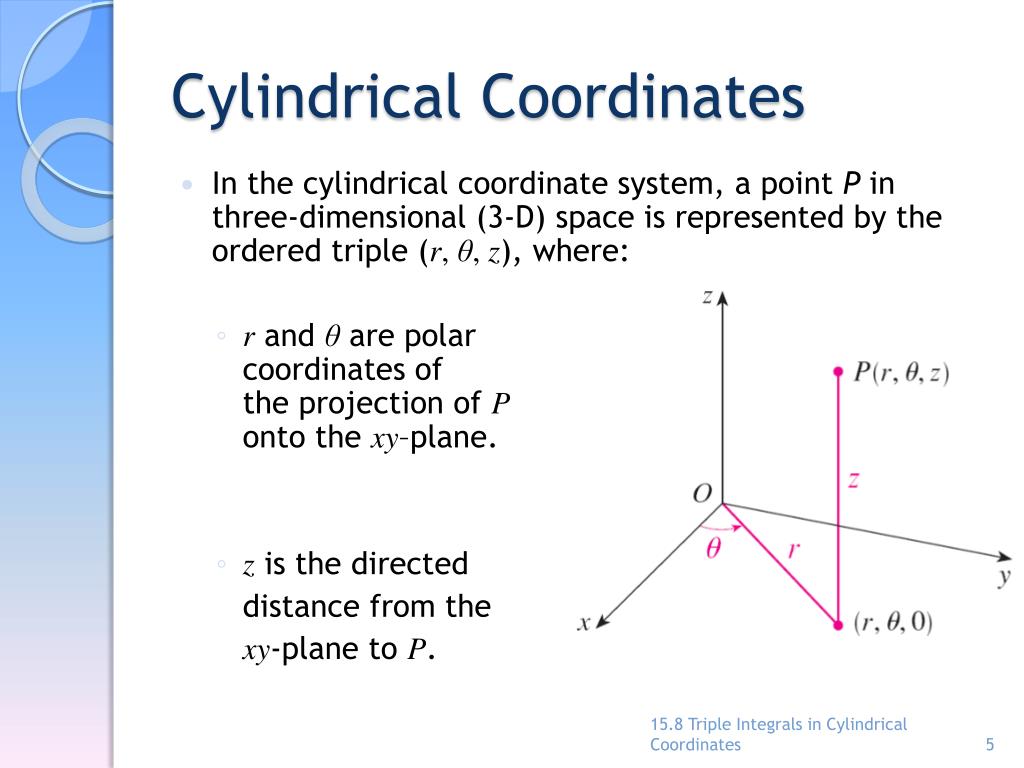
R = ρ sin φ These equations are used to convert from θ = θ spherical coordinates to cylindrical z = ρ cos φ coordinates. Last, what about θ = c ? θ = c ? The points on a surface of the form θ = c θ = c are at a fixed angle from the x-axis, which gives us a half-plane that starts at the z-axis ( Figure 2.91 and Figure 2.92). In other words, these surfaces are vertical circular cylinders. The points on these surfaces are at a fixed distance from the z-axis. Now, let’s think about surfaces of the form r = c. Therefore, in cylindrical coordinates, surfaces of the form z = c z = c are planes parallel to the xy-plane. When we convert to cylindrical coordinates, the z-coordinate does not change.

Planes of these forms are parallel to the yz-plane, the xz-plane, and the xy-plane, respectively. If c c is a constant, then in rectangular coordinates, surfaces of the form x = c, x = c, y = c, y = c, or z = c z = c are all planes. Let’s consider the differences between rectangular and cylindrical coordinates by looking at the surfaces generated when each of the coordinates is held constant. Right-triangle relationships tell us that x = r cos θ, x = r cos θ, y = r sin θ, y = r sin θ, and tan θ = y / x. To make this easy to see, consider point P P in the xy-plane with rectangular coordinates ( x, y, 0 ) ( x, y, 0 ) and with cylindrical coordinates ( r, θ, 0 ), ( r, θ, 0 ), as shown in the following figure.įigure 2.90 The Pythagorean theorem provides equation r 2 = x 2 + y 2. Notice that these equations are derived from properties of right triangles. Note that if x = 0, x = 0, then the value of θ θ is either π 2, 3 π 2, π 2, 3 π 2, or 0, 0, depending on the value of y. However, if we restrict θ θ to values between 0 0 and 2 π, 2 π, then we can find a unique solution based on the quadrant of the xy-plane in which original point ( x, y, z ) ( x, y, z ) is located. and r 2 = x 2 + y 2 These equations are used to convert from tan θ = y x rectangular coordinates to cylindrical z = z coordinates.Īs when we discussed conversion from rectangular coordinates to polar coordinates in two dimensions, it should be noted that the equation tan θ = y x tan θ = y x has an infinite number of solutions. x = r cos θ These equations are used to convert from y = r sin θ cylindrical coordinates to rectangular z = z coordinates. and r 2 = x 2 + y 2 These equations are used to convert from tan θ = y x rectangular coordinates to cylindrical z = z coordinates. X = r cos θ These equations are used to convert from y = r sin θ cylindrical coordinates to rectangular z = z coordinates. In this way, cylindrical coordinates provide a natural extension of polar coordinates to three dimensions. Starting with polar coordinates, we can follow this same process to create a new three-dimensional coordinate system, called the cylindrical coordinate system. When we expanded the traditional Cartesian coordinate system from two dimensions to three, we simply added a new axis to model the third dimension. Similarly, spherical coordinates are useful for dealing with problems involving spheres, such as finding the volume of domed structures. As the name suggests, cylindrical coordinates are useful for dealing with problems involving cylinders, such as calculating the volume of a round water tank or the amount of oil flowing through a pipe. In this section, we look at two different ways of describing the location of points in space, both of them based on extensions of polar coordinates. This is a familiar problem recall that in two dimensions, polar coordinates often provide a useful alternative system for describing the location of a point in the plane, particularly in cases involving circles. Some surfaces, however, can be difficult to model with equations based on the Cartesian system. The Cartesian coordinate system provides a straightforward way to describe the location of points in space.


2.7.4 Convert from rectangular to spherical coordinates.2.7.3 Convert from spherical to rectangular coordinates.2.7.2 Convert from rectangular to cylindrical coordinates.2.7.1 Convert from cylindrical to rectangular coordinates.


 0 kommentar(er)
0 kommentar(er)
